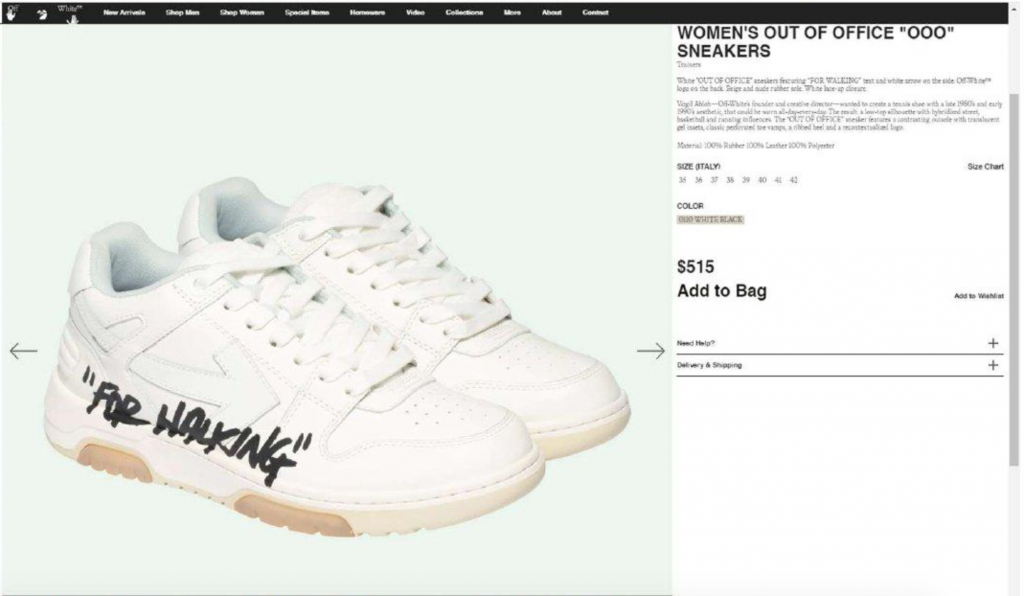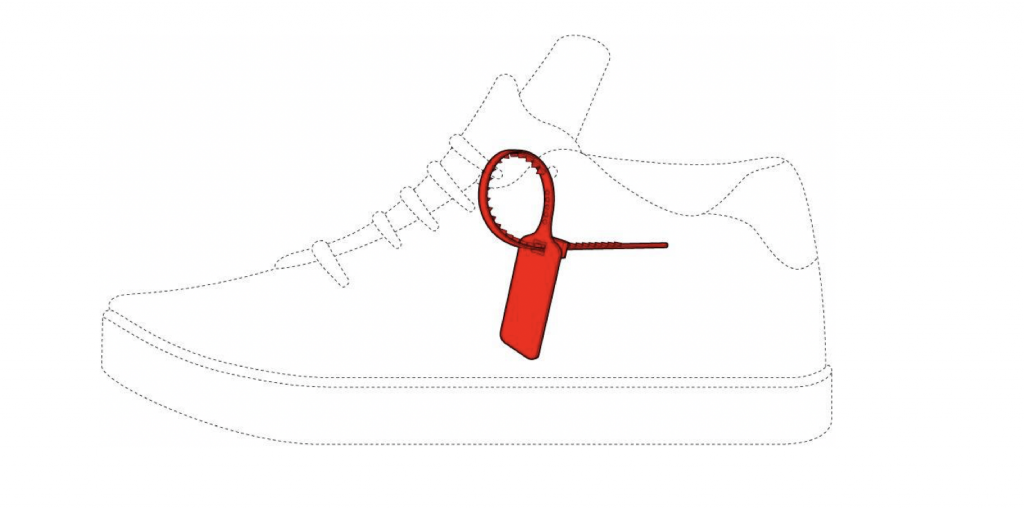Off-White is doubling-down on the argument that its use of quotation marks acts as an indicator of source in the same way as other trademarks, with the buzzy brand lodging a trademark application for “For Walking” – quotation marks included – for use on … footwear with the U.S. Patent and Trademark Office (“USPTO”) in late October. The application is the latest quotation-centric trademark filing from the brand, joining the already-pending one that the Virgil Abloh-helmed company filed for “Product Bag” for use on “tops as clothing; bottoms as clothing” in May 2019. And just as in the case of the “Product Bag” application, the USPTO is taking issue with Off-White’s quest to register “For Walking,” issuing a non-final Office Action early this year.
In a January 6 Office Action, an examining attorney for the USPTO has preliminarily refused to allow Off-White’s application to move forward in the registration process on the basis that the “For Walking” mark “merely describes a feature and purpose of [Off-White’s] goods.” According to the letter, examining attorney Shaunia Carlyle states that a mark is merely descriptive of the goods or services cited in the application “if it describes an ingredient, quality, characteristic, function, feature, purpose, or use of an applicant’s goods and/or services,” and that is precisely what is going on here, as “WALKING is an activity done on foot,” meaning that “the wording [of the “FOR WALKING” mark] describes a purpose of the goods – to be used FOR WALKING.”
Carlyle elaborates, citing the U.S. Court of Appeals for the Federal Circuit, which held in In re Oppedahl & Larson LLPthat “a mark may be merely descriptive even if it does not describe the ‘full scope and extent’ of the applicant’s goods or services.” Instead, “it is enough if a mark describes only one significant function, attribute, or property.”
Off-White now has six months to either submit arguments and evidence in support of registration on the USPTO’s Principal Register or to amend its application for registration to the Supplemental Register, a separate register that provides protection for non-distinctive marks that may be capable of acquiring distinctiveness.

The Red Zip Tie
Meanwhile, the USPTO recently issued a separate Office Action for another pending Off-White trademark application: this time in connection with Abloh’s brand’s quest to register a red zip tie for use on footwear. Off-White has faced repeated pushback from the USPTO since it filed its application for the zip tie mark back in July 2018, with the examining attorney setting out an array of bases for preliminary refusal – including functionality and non-distinctiveness – in three Office Actions prior to the most recent one.
In the latest zip tie Office Action, which was filed on January 6 and which follows from Off-White’s submission of a new drawing to show the placement of the zip tie (as opposed to its previously-submitted drawing, which showed just the shape and color of the zip tie, itself), USPTO examiner Verna B. Ririe asserts that “based on the amended drawing, registration is [still] refused.” The reason? “Because the applied-for mark as used on the specimen of record is merely a decorative or ornamental feature of the goods and, thus, does not function as a trademark to indicate the source of applicant’s goods and to identify and distinguish them from others.”
Ririe states that here, “the mark as shown on the specimen would be perceived as merely a decorative or ornamental feature of the goods because the specimens” – i.e., examples of how Off-White is actually using the mark – show that it is used “as a decorative feature of footwear such that consumers are induced to buy the goods because of this decorative feature.” There is likely an argument to be made that consumers are, in fact, drawn to Off-White sneakers that bear the red zip tie. However, at the same time, it could be argued that the allure of the red zip on those sneakers is not the result of the appearance of the zip tie on its own on those sneakers. In other words, it is not the sheer aesthetics of the zip tie that prompt consumers to shell out hundreds of dollars for Off-White footwear.
Instead, the consumer demand for such zip tie-adorned sneakers is more precisely a direct result of the fact that certain consumers link the zip tie to the Off-White brand and thus, want to own the sneakers due to the source-identifying function that the zip tie plays, and the goodwill associated with the little red plastic tag, at least some of which bear the Off-White word mark, according to a response that the brand provided to the USPTO last year.

To date, Off-White has responded to opposition from the USPTO over the zip tie, arguing that the its use of the red zip tie has amassed the requisite level of secondary meaning in the minds of consumers to function as a trademark as a result of widespread media attention, advertising, and sales. The 8-year old brand argued that the zip tie has become so well known that “when consumers see [it] affixed to [Off-White’s] goods, they immediately understand the product to have originated with [Off-White].”
Proof of that, according to the brand: the fact that “many consumers who purchase [Off-White products] choose to leave [the zip tie] affixed to the outside of the product, even though it could be easily removed.”
In addition to making its case for secondary meaning, Off-White has taken issue with a previously-asserted non-distinctive configuration refusal, asserting in its March 2020 response to a previous USPTO Office action that the zip tie is not actually part of any of its sneaker product designs, but instead, “is more properly classified as product packaging,” which is significant, as product packaging can be inherently distinctive, thereby, removing the need to establish acquired distinctiveness. (It is worth noting that Ririe states in her January 6 Office Action that the non-distinctive configuration – and the functionality – refusals have been withdrawn).
As for what Off-White can do next, Ririe notes that “in appropriate circumstances, an applicant may overcome [a “merely descriptive”] refusal” in a number of ways, including – but not limited to – amending its application to seek registration in the Supplement Register, claiming acquired distinctiveness by submitting evidence that the applied-for mark has become distinctive of applicant’s goods (“that is, proof that applicant’s extensive use and promotion of the mark has allowed consumers now directly to associate the mark with applicant as the source of the goods”), or amend the filing basis to intent to use under Section 1(b), the latter of which is what Off-White did with its pending “Product Bag” application, for which it received a notice of allowance in December.
Taken together, these trademarks – which are capable of falling within the Lanham Act’s sweeping definition of a trademark as any matter used “to identify and distinguish [one party’s] goods . . . from those manufactured or sold by others and to indicate the[ir] source” – and Off-White’s quest to amass registrations for them comes in furtherance of the brand’s practice of adopting otherwise ordinary marks (from zip ties to various arrow designs), and applying them to its graphic-centric garments and accessories as indicators of the source of the products and driving consumer appeal in connection with such marks in much the same way that luxury brands have done for decades – or in some cases, centuries.














